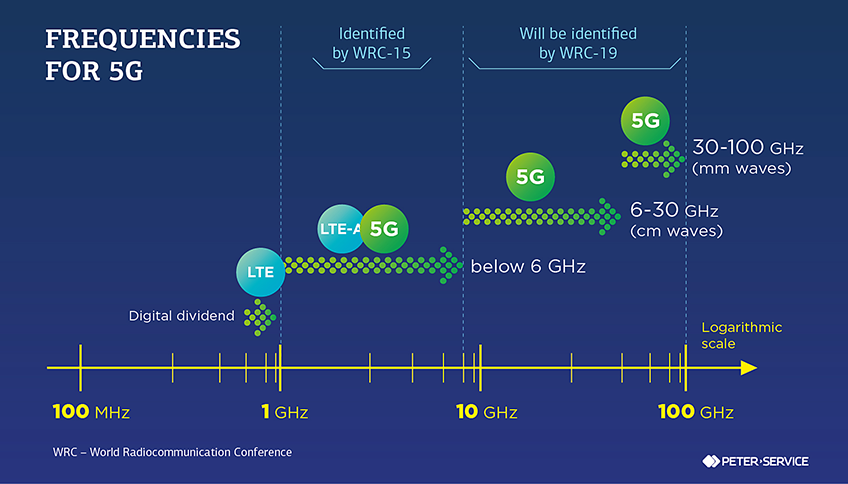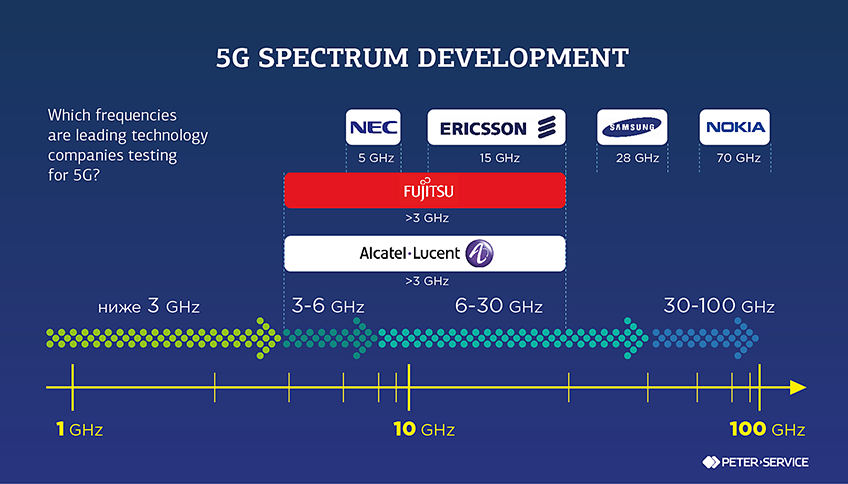Where will operators find frequencies for 5G?
And who will have to leave the spectrum for fifth-generation networks?
Operators are having a sharp eye on the developing standards and technologies for 5G. One of the most important questions for them is selecting new frequencies for the fifth-generation connectivity.
5G: What is it for?
Mobile connectivity is constantly developing: roughly every 10 years see a transfer to a new generation of communication technology. From 1G the world switched to 2G, then to 3G and 4G.

Already at the 3G stage, mobile connectivity demonstrated a significant drift towards the Internet. And after the switch to 4G, Data not just outpaced, but replaced traditional service altogether. Messengers came as a substitution of SMS and MMS, and Skype, FaceTime and, again – messengers, replaced voice communication. Moreover, these apps offered not only Voice, but also video connectivity.
Mobile internet is rapidly spreading both in developed and developing countries. All forecasts say that in the next five years, mobile internet will outperform fixed access by the number of users. In some countries, e.g. in India, this has already happened, and, moreover, a portion of users completely switched from fixed Broadband to Mobile.
Users badly need to access the Internet from their mobile phones and operators must find ways to provide it. At the same time, OTT services are growing at a huge pace. While earlier users only needed messengers and social networks, today they demand access to online music and video, and these services do constantly offer improving sound and picture quality.
For instance, Korea is planning to raise the throughput of mobile networks, any times higher by 2018 Winter Olympics. Users will be able to use mobile internet at a speed of 5 Gbps which already meets 5G standards. This will allow to watch videos from the Olympics on mobile devices with an incredible resolution and without stalling, and to stream your own recordings right from sport venues.
Yet, the Internet demands of real users fade away compared to the growing Internet of Things. IoT is embracing an increasing number of areas: yesterday this was the case with ATMs and leak sensors and tomorrow this will happen to self-driving cars, drones and a vast number of sensors for Smart Home, City and Office. Just imagine the amount and the transmission speed of data required by a processing hub of a busy motorway in rush hours for self-driving cars to move fast and safely.
5G: what it can and cannot do?
Based on the described cases, the following initial requirements for 5G have been formed:

Interestingly, all 5G requirements are mainly related to mobile internet usage and do not concern voice calls and SMS. In other words, the Internet has taken the lead completely and operators will have to handle more petabytes of data per month.
Addressing the issue of meeting the defined 5G requirements is the task of technology companies and institutions which are actively working on new standards and technologies already today. In the same vein, operators' task is to think about necessary frequencies as they will have to obtain and manage them.
Why do we need new frequencies for 5G?
The evolution of wireless networks is a fast, yet steady, process: new standards do not replace older ones in a day. A long time after the planned launch of 5G in 2020 many subscribers and devices will continue supporting 4G only and other previous standards.
This is why deploying 5G on the frequencies currently used by 3G and 4G will not work. In theory, they can be tailored to 5G, yet, for now, a more probable and currently explored scenario is using separate frequencies for fifth-generation networks.
The bandwidth that will be required for 5G is expected to be in the range between 500 Mhz and 1GHz, which is 5 to 10 times higher than what is needed for 4G. This is to say that the frequencies higher than those currently used by operators are prioritized. The advantage of using high frequencies is that, for instance, it is possible to use simplified signal modulation. However, it also has a downside, as new technologies are required to cater for all physical specifics of operating at these wavelengths.
Who will have to leave the spectrum for operators?
Simply put, no one.
4G acquired a number of frequencies during the digital television transition. After the launch of digital TV broadcasting, analog TV was phased out and the released frequencies, the so-called Digital Dividend, were transferred to mobile operators.

5G expects nothing like this to happen. Effectively, the 6-100 GHz range includes a sufficient number of unengaged frequencies, even with the required 1 GHz band. The 6-100 GHz range is considered a priority for 5G in the EU, USA, Japan and South Korea, with higher frequencies, or, namely, 30-100 GHz, believed to be the most promising for today. Development of frequencies beyond 100 GHz is at an early stage, but they can be used for mobile data transmission when the time comes.
Who will decide which frequencies to designate for 5G?
International organizations are developing common approaches and can make recommendations, but national ministries in each country, in theory, can use their own vision.
This is what they probably will do, because the 6-100 GHz spectrum has different frequencies depending on the country. E.g. in the NATO states this range includes a number of frequencies reserved for military communication. Other countries, including Russia, have a different list of vacant and occupied frequencies within this range.
Unlike satellite broadcasting operating in a similar frequency range, cellular networks are not restricted by weather and other geographic parameters of countries because cell towers are installed on the ground and do not have to deal with cloudiness or torrential rains. Possible differences in signal reception and transmission tend to be related to the topography of individual locations. E.g. high-frequency broadcasting in New York, London and Moscow will require specific changes in placing and tuning of base stations.
In any case, until the WRC-19 Conference the active development of new standards will continue, and only after 2019 we will be able to discuss which frequencies will be prioritized in terms of technologies. Again, not until this moment, individual countries will start adapting proposed standards to their specific conditions, organize frequency auctions and take other steps for the practical implementation of 5G.
All this does not impede initiatives of the countries themselves, aimed at fostering 5G projects. The above mentioned 2018 Winter Olympics in Korea is one example.
What technologies will be needed for working in new frequencies?
There are lots of them. Firstly, the antennas will change, both at base stations and in receiving devices. Secondly, there will be a big spread of MIMO (multiple-input and multiple-output), TDD (time-division duplexing) and other technologies helping improve network performance and ensure delivery of 5G Internet to individual users with at a required speed. Thirdly, software will also evolve, with NFV and SDN gaining more power.

Today, technology companies are actively developing their own solutions in these areas. By 2020, operators will understand the functionality offered by different vendors and will have to select the solutions they need, considering features of their subscriber bases, topographies of populated areas, regulatory requirements and available frequencies.
What happens after the launch of 5G?
Experts stress that 5G is not an evolution, rather a revolution.
After the full launch of 5G, mobile internet will completely catch up with fixed access in coverage and speed. The Internet of Things will gain the required scale and outpace the Internet of Humans by the number of connections. There will be a basis for the Internet-of-Everything, i.e. users will be able to interact with vast amounts of new data – from readings of autonomous transport in cities to constantly working medical sensors on their bodies.
Probably, we will see dedicated projects for integrating fixed and mobile internet for a seamless transition of users between the two types. Selection of 5G frequencies can also influence this process. E.g. for WiGig networks (Wi-Fi having a throughput starting at 1 Gbps) the selected frequency range is 30-100 GHz, the same that can be used for 5G as well.
Potentially, the same antenna in a smartphone can receive both 5G and WiGig signals. If similar frequencies are reserved for WiGig and 5G, it will be possible to reduce the number of components inside the phone and completely change user behavior. They will not need to think whether to connect to mobile internet or Wi-Fi – the switch will happen automatically.
Certainly, the development of mobile networks will not stop after the launch of 5G. Further, there will be a new question about reaching speeds up to 100 Gbps, which will again require new frequencies. Many technological companies and research institutions are considering to utilize the range of 1 THz and beyond for these purposes.
Yet, for now, the implementation of 5G remains the priority. Already today, operators need to expect that the new wireless generation will change requirements for base stations, user devices, as well as operators' services and products. Each area in the long 5G journey can be potentially exploited by operators for improving their technological, user and financial indicators.
Finding an optimum solution for 5G will help operators both "stay afloat" and reap dividends from the looming revolutions. Selecting the right frequencies for 5G can be a significant push for operators' success on the path to the established goals.
Stay connected!